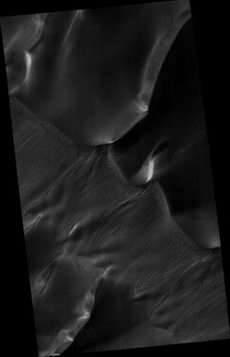HiRISE Team Begins Releasing a Flood of Mars Images Over the Internet

The University of Arizona-based team that operates the high-resolution camera on NASA's Mars Reconnaissance Orbiter, in conjunction with NASA, is releasing the first of what will be a non-stop flood of incredibly detailed Mars images taken during the spacecraft's two-year primary science mission.
The High Resolution Science Imaging Experiment (HiRISE) camera took almost 100 images during the first two weeks of its main science mission, which began Nov. 7.
"There's no Earth analog for some places we see, while other places look remarkably like Earth," said Professor Alfred S. McEwen of UA's Lunar and Planetary Laboratory, HiRISE principal investigator. "The details we're seeing are just fantastic."
The HiRISE team is posting about 15 of the new large images on the HiRISE Website hiroc.lpl.arizona.edu today. Last week, they added more than a dozen new Mars images, as well as reprocessed images, taken from low orbit during test imaging in early October. The team plans to release the latest HiRISE images on their Website every Wednesday.
The views released today show seemingly endless fields of sand dunes, including some carved by gullies that possibly form when carbon dioxide or water frost in the dunes is heated by sunlight, triggering avalanches of flowing sand. Other HiRISE images show layered arid terrains that resemble landscapes protected as national parks on our own planet, and a fossil delta inside a crater that once held a lake. HiRISE images resolve meter-sized blocks within the delta channel that may be blocks of sand and gravel carried along as the channels eroded.
HiRISE images also capture numerous impact craters, including Endurance crater that NASA's Opportunity rover explored for ten months of its now nearly 3-year mission. Details visible in the HiRISE image of Opportunity's landing site show the parachute lying on the Martian surface, Opportunity's heat shield at a different location, and the lander itself on the floor of the small impact crater where the airbag came to a stop.
Other images show layered polar terrains that likely record Martian climate changes, and also polygon-patterned northern plains regions that are among candidate landing sites for the Phoenix Lander spacecraft in 2008.
"You see stuff at this level of detail and you want to see more," said Candy Hansen of the Jet Propulsion Laboratory, a HiRISE co-investigator who has helped lead imaging operations at the HiRISE Operations Center (HiROC) during the first weeks of the science mission this month.
"These images are at a geologist's scale," Hansen said. "A geologist could hike the terrain seen in the width of one of our images, six kilometers, in a day. These images bring the planet down to scales that match our own human level of experience, and that's a big help with interpretation."
The HiRISE camera takes images of 3.5-mile-wide (6 kilometer) swaths as the orbiter flies at about 7,800 mph between 155 and 196 miles (250 to 316 km) above the planet. The camera resolves geologic features as small as 40 inches across.
"It's been a constant race to look at all these images while we're planning our future targets," McEwen said. "But it's important to examine the data so we can learn how to use the best possible settings, and make decisions about which targets we'll need to get in stereo or color."
HiRISE began a new imaging cycle last week (Nov. 19) and begins another next week (Dec. 3). Over the next couple of weeks, the camera is targeting "all the easy-to-find hardware on Mars," McEwen said. That includes NASA's rover Spirit, the Viking 1 and Viking 2 landers, and Mars Pathfinder.
McEwen has been working a 12-hour day, seven days a week this month. The rest of the team has been clocking major overtime, too.
"We're trying not to get people too burned out, but we have to keep up. We're going to get about a hundred new images every two weeks without a break," McEwen said. "The spacecraft doesn't take Thanksgiving or Christmas off."
Source: University of Arizona





















